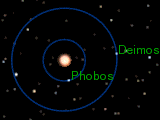14 May 2007
FAQ's
Hi Friends! I hope this blog has been interesting so far. I have decided to make it more interesting. I have been giving some interesting facts to you but now you can ask me any topic you are interested and I'll try to post related to it. You can also ask me any queries and I'll try to answer them as soon as possible. You can ask me your queries via e-mail or the chatter box in this blog. You can mail me to incharaprakash@gmail.com Hope you would find this interesting.
6 May 2007
The Secrets of Mars
Mars – named after the Roman God of War – is the fourth planet in our solar system. It has two natural satellites revolving around it - Phobos and Deimos.
Both these satellites are named after the sons of Ares (Mars) from Greek Mythology. These satellites are quite unique in their nature. They are actually escaped asteroids which are bound under the gravity of Mars. The picture on the left is Phobos and the one below is Deimos.

Phobos has a unique property. It moves very close of the planet; it moves approximately at a distance of 9380 km away from Mars. Phobos also orbits at a very high velocity such that the time tak en for Phobos to make one revolution around Mars is quicker than the time taken for Mars to make one rotation around its axis. Due to this Phobos appears to rise in the west and set in the east unlike any other satellites in our solar system. Also due to the high velocity Phobos rises and sets twice in one Mars day (which is also aprrox. 24 hrs.) This makes Phobos a unique satellite in our solar system.
en for Phobos to make one revolution around Mars is quicker than the time taken for Mars to make one rotation around its axis. Due to this Phobos appears to rise in the west and set in the east unlike any other satellites in our solar system. Also due to the high velocity Phobos rises and sets twice in one Mars day (which is also aprrox. 24 hrs.) This makes Phobos a unique satellite in our solar system.
The above picture shows the orbital motion of the two satellites of Mars.
Both these satellites are named after the sons of Ares (Mars) from Greek Mythology. These satellites are quite unique in their nature. They are actually escaped asteroids which are bound under the gravity of Mars. The picture on the left is Phobos and the one below is Deimos.

Asteroids are tiny pieces of rocks which are found in between the orbit of Mars and Jupiter which orbits the Sun. The picture below shows the Asteroid belt. Phobos and Deimos escaped from their orbit and they were captured by the strong gravitational force of Mars. Thus Phobos and Deimos were forced to orbit around the Mars.
Phobos has a unique property. It moves very close of the planet; it moves approximately at a distance of 9380 km away from Mars. Phobos also orbits at a very high velocity such that the time tak
 en for Phobos to make one revolution around Mars is quicker than the time taken for Mars to make one rotation around its axis. Due to this Phobos appears to rise in the west and set in the east unlike any other satellites in our solar system. Also due to the high velocity Phobos rises and sets twice in one Mars day (which is also aprrox. 24 hrs.) This makes Phobos a unique satellite in our solar system.
en for Phobos to make one revolution around Mars is quicker than the time taken for Mars to make one rotation around its axis. Due to this Phobos appears to rise in the west and set in the east unlike any other satellites in our solar system. Also due to the high velocity Phobos rises and sets twice in one Mars day (which is also aprrox. 24 hrs.) This makes Phobos a unique satellite in our solar system.The above picture shows the orbital motion of the two satellites of Mars.
1 May 2007
Picture of the Month - May 2007

(Click on the picture for the best view)
This series of images which was taken by a satellite and fused together shows the Earth during the night time. The continents are seen clearly due to the light of the Full Moon. But what is more astonishing is the brightness of the city lights. The city lights are so bright that it could actually be seen from space. These lights mark the developed areas on Earth. The eastern part of USA and west Europe are the brightest parts which are considered as the most developed areas. Whereas in Asia, Japan, east coast of China, Malaysia, Singapore and most parts of India are glittering with the city lights.
Subscribe to:
Posts (Atom)


